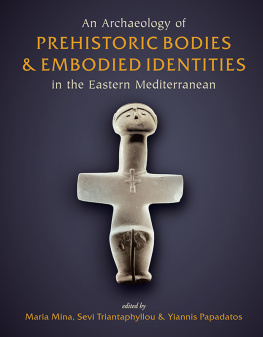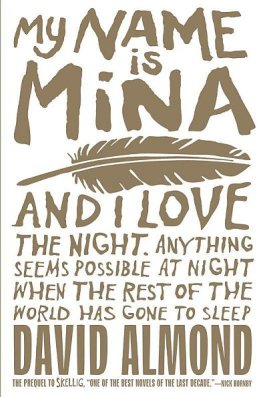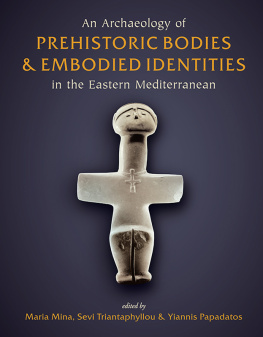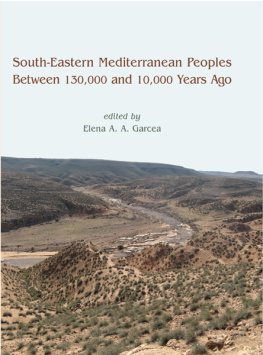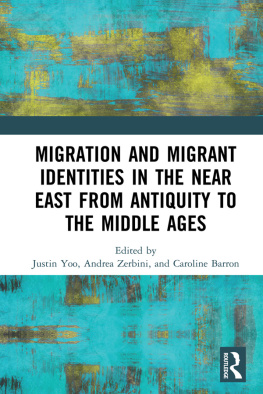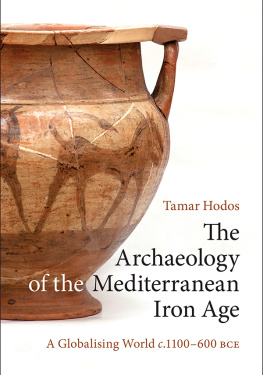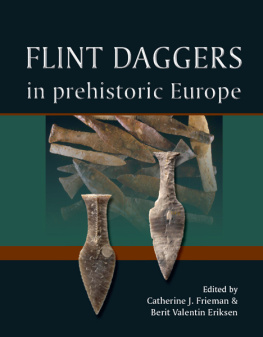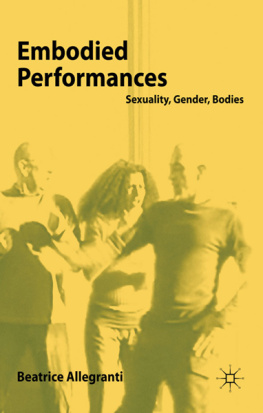Mina Maria - An Archaeology of Prehistoric Bodies and Embodied Identities in the Eastern Mediterranean
Here you can read online Mina Maria - An Archaeology of Prehistoric Bodies and Embodied Identities in the Eastern Mediterranean full text of the book (entire story) in english for free. Download pdf and epub, get meaning, cover and reviews about this ebook. year: 2016, publisher: Oxbow Books, Limited, genre: Romance novel. Description of the work, (preface) as well as reviews are available. Best literature library LitArk.com created for fans of good reading and offers a wide selection of genres:
Romance novel
Science fiction
Adventure
Detective
Science
History
Home and family
Prose
Art
Politics
Computer
Non-fiction
Religion
Business
Children
Humor
Choose a favorite category and find really read worthwhile books. Enjoy immersion in the world of imagination, feel the emotions of the characters or learn something new for yourself, make an fascinating discovery.
- Book:An Archaeology of Prehistoric Bodies and Embodied Identities in the Eastern Mediterranean
- Author:
- Publisher:Oxbow Books, Limited
- Genre:
- Year:2016
- Rating:3 / 5
- Favourites:Add to favourites
- Your mark:
- 60
- 1
- 2
- 3
- 4
- 5
An Archaeology of Prehistoric Bodies and Embodied Identities in the Eastern Mediterranean: summary, description and annotation
We offer to read an annotation, description, summary or preface (depends on what the author of the book "An Archaeology of Prehistoric Bodies and Embodied Identities in the Eastern Mediterranean" wrote himself). If you haven't found the necessary information about the book — write in the comments, we will try to find it.
Mina Maria: author's other books
Who wrote An Archaeology of Prehistoric Bodies and Embodied Identities in the Eastern Mediterranean? Find out the surname, the name of the author of the book and a list of all author's works by series.
An Archaeology of Prehistoric Bodies and Embodied Identities in the Eastern Mediterranean — read online for free the complete book (whole text) full work
Below is the text of the book, divided by pages. System saving the place of the last page read, allows you to conveniently read the book "An Archaeology of Prehistoric Bodies and Embodied Identities in the Eastern Mediterranean" online for free, without having to search again every time where you left off. Put a bookmark, and you can go to the page where you finished reading at any time.
Font size:
Interval:
Bookmark:

Published in the United Kingdom in 2016 by
OXBOW BOOKS
10 Hythe Bridge Street, Oxford OX1 2EW
and in the United States by
OXBOW BOOKS
1950 Lawrence Road, Havertown, PA 19083
Oxbow Books and the individual authors 2016
Hardcover Edition: ISBN 978-1-78570-291-4
Digital Edition: ISBN 978-1-78570-292-1 (epub)
Digital Edition: ISBN 978-1-78570-293-8 (mobi)
Digital Edition: ISBN 978-1-78570-294-5 (PDF)
A CIP record for this book is available from the British Library and the Library of Congress
All rights reserved. No part of this book may be reproduced or transmitted in any form or by any means, electronic or mechanical including photocopying, recording or by any information storage and retrieval system, without permission from the publisher in writing.
Printed in Malta by Gutenberg Press
For a complete list of Oxbow titles, please contact:
UNITED KINGDOM
Oxbow Books
Telephone (01865) 241249, Fax (01865) 794449
Email:
www.oxbowbooks.com
UNITED STATES OF AMERICA
Oxbow Books
Telephone (800) 791-9354, Fax (610) 853-9146
Email:
www.casemateacademic.com/oxbow
Oxbow Books is part of the Casemate Group
Front cover: Chalcolithic cruciform figurine from Pomos, Cyprus (Cyprus Museum, 1934/III-2/2). Photograph courtesy of the Department of Antiquities, Cyprus.
Contents
Introduction. The Archaeology of Bodies and the Eastern Mediterranean
John Robb
Polydactyly in Chalcolithic Figurines from Cyprus
Michelle Gamble, Christine Winkelmann and Sherry C. Fox
Figurines, Paint and the Perception of the Body in the Early Bronze Age Southern Aegean
Yiannis Papadatos
Thoughts on the Funerary Use of the Early Bronze Age (EBA) Cycladic Figurines: Iconography, Form, Context and Embodied Lives
Dimitra Goula
Composite, Partial, Created and Floating Bodies: a Re-Assessment of the Knossos Temple Repositories Assemblage
Fay Stevens and Anna Simandiraki-Grimshaw
Figurines and Complex Identities in Late Bronze Age Cyprus
Daisy Knox
Handlers and Viewers: Some Remarks on the Process of Perception of Terracotta Figurines on the Example of Cypriot Goddesses with Upraised Arms
Katarzyna Zeman-Winiewska
Re-Making the Self: Bodies, Identities and Materialities in Chalcolithic Cyprus
Diane Bolger
Pots and People: An Investigation of Individual and Collective Identities in Early Bronze Age Cyprus
Jennifer M. Webb
Dressed to Impress: Metal Objects and Embodied Identities in Early and Middle Bronze Age Cyprus
Maria Mina
Placed with Care: Interaction with Decorated Mycenaean Metal Vessels
Stephanie Aulsebrook
The Performative Body and Social Identity in the Room of the Fresco at Mycenae
Anne P. Chapin
Its War, not a Dance: Polarising Embodied Identities in the Aegean and the Eastern Mediterranean from the End of the Bronze Age to the Early Iron Age, 1200700 BC
Manolis Mikrakis
Nuptial Vases in Female Tombs? Aspects of Funerary Behaviour during the Late Geometric Period in Attica
Vicky Vlachou
Turning into Stone: Rock Art and the Construction of Identities in Ancient Thrace
Stella Pilavaki
Lithics and Identity at the Middle Palaeolithic site of Lakonis Cave I, Southern Peloponnese, Greece
Paraskevi Elefanti and Eleni Panagopoulou
Picrolite and Other Stone Beads and Pendants: New Forms in an Old Material during the Transition from the Chalcolithic to the Cypriot Bronze Age
Giorgos Georgiou
The Embodiment of Land Ownership in the Aegean Early Bronze Age
Ourania Kouka
From Potters Mark to the Potter Who Marks
Kostis Christakis
Grasping Identity: Theoretically informed Human Bioarchaeology in or for the Eastern Mediterranean?
Kirsi O. Lorentz
Headshaping and Identity at Tell Nader
Konstantinos Kopanias and Sherry C. Fox
Constructing Identities by Ageing the Body in the Prehistoric Aegean: the View through the Human Remains
Sevi Triantaphyllou
Secondary Burials and the Construction of Group Identities in Crete between the Second Half of the 4th and 2nd Millennia BC
Luca Girella and Simona Todaro
Bodies in a Pickle: Burial Jars, Individualism and Group Identities in Middle Minoan Crete
Borja Legarra Herrero
Fire, Fragmentation and the Body in the Late Bronze Age Aegean
Yannis Galanakis
Spatial and Temporal Variability in Identity and Representation within the Bronze Age Cemeteries of Knossos, Crete
Eleni Hatzaki
Collective Selves and Funerary Rituals. Early Mycenaean Dromoi as Spaces of Negotiation and Embodiment of Social Identities
Nikolas Papadimitriou
Burning People, Breaking Things: Material Entanglements, the Bronze Age/Iron Age Transition and the Homeric Dividual
James Whitley
Epilogue: Bodies in the Eastern Mediterranean
Kostas Kotsakis
Preface and Acknowledgements
The essays included in this volume were originally presented at the conference Embodied Identities in the Prehistoric Eastern Mediterranean: Convergence of Theory and Practice , which was held in Nicosia, Cyprus on 1012 April 2012. The idea to organise an international conference that focused on the body stemmed from the realisation that many of us archaeologists working in the eastern Mediterranean often touch on the subject of bodies, each in his or her own field of expertise, but rarely are the results of our research discussed within a common framework of the archaeology of the body. The aims of the conference were threefold: (a) to instigate a dialogue between archaeologists who study aspects relating to the body, (b) to encourage archaeologists working in the eastern Mediterranean to reappraise archaeological evidence through body-focused theoretical and methodological approaches, and (c) to highlight the way an archaeology of the body can contribute to a nuanced understanding of prehistoric cultures of the eastern Mediterranean. By encouraging the contributors to discuss their topics with relevance to their particular sets of data, we also aimed to bridge the gap that occasionally occurs between the disciplines often ambitious theoretical pursuits and the actual application of methodological strategies on the archaeological record.
Recent archaeological research has raised awareness about the relevance of the body in understanding collective and individual identities, shared or subjective experiences, symbolic meanings, existential perceptions, and social and cultural practices in past societies. This growing interest in body-focused research is also reflected in the bibliography related to the eastern Mediterranean, as indicated by the works of Hamilakis (2004; 2012), Knapp and Meskell (1997), Morris and Peatfield (2002), Meskell and Joyce (2003), Malafouris (2008), Lorentz (2009), Bulger and Joyce (2012), Simandiraki-Grimshaw (2015), to name but a few. This collection of essays, therefore, aims to contribute to past and ongoing archaeological research in the eastern Mediterranean that relates to the role of the body and embodiment in shaping prehistoric identities. The publication of this volume also reflects the conferences original scope which was to connect archaeologists working in the eastern Mediterranean, beyond the regional limits of their area of expertise, to the broader debates currently contested in the archaeology of the body. Furthermore, the essays included in this volume throw new light on already known and even new sets of data of the prehistoric eastern Mediterranean, but also open up the field to a discourse with archaeologists working in different parts of the world.
The content of the volume reflects the range of themes that were originally presented at the conference and portrays a picture of the areas of interest that occupy archaeologists working in the eastern Mediterranean. Regarding the organisation of the book, we have deliberately avoided grouping the essays according to chronological or regional criteria that would only serve to reproduce the restrictions of old scholarly traditions. By breaking down regional or chronological barriers, therefore, the volume brings together essays that highlight how different sets of data can contribute to our knowledge about themes that pertain to the perception, construction and performance of prehistoric identities. A final point that should be addressed is that the volume is heavily dominated by essays largely written by archaeologists trained in the Anglo-American tradition that focus on the archaeology of the Aegean and Cyprus. Admittedly, we deeply regret the absence of essays on the archaeology of the Balkans (with the exception of Greece), Anatolia, the Levant and the north-eastern African coast, which is nevertheless telling about the dominant trends in the research pursuits in these archaeological fields, the deeply rooted scholarly traditions, and even the hindrances that may be caused by the current state of political affairs in the wider region. Another trend that is apparent in the range of essays included in the volume is a heavy bias towards the Bronze Age, as opposed to earlier periods, which on one hand may be explained in relation to the availability of archaeological evidence, but on the other may also betray archaeologists uneasiness to apply body-centred theory to a less robust archaeological record.
Next pageFont size:
Interval:
Bookmark:
Similar books «An Archaeology of Prehistoric Bodies and Embodied Identities in the Eastern Mediterranean»
Look at similar books to An Archaeology of Prehistoric Bodies and Embodied Identities in the Eastern Mediterranean. We have selected literature similar in name and meaning in the hope of providing readers with more options to find new, interesting, not yet read works.
Discussion, reviews of the book An Archaeology of Prehistoric Bodies and Embodied Identities in the Eastern Mediterranean and just readers' own opinions. Leave your comments, write what you think about the work, its meaning or the main characters. Specify what exactly you liked and what you didn't like, and why you think so.

